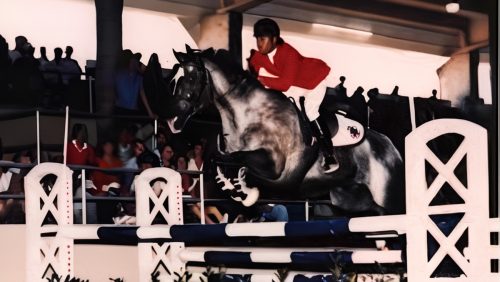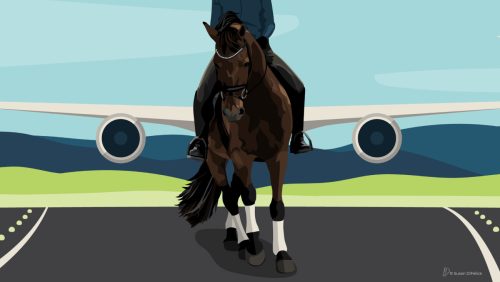A few years ago, a local teen looking for community service hours asked if she could volunteer with our summer camp program. She had been a student for several years at another local facility, a stable that regularly attended rated shows and had a reputation for building strong riders, so I agreed. But the first time I asked her to tack up a pony, she was a deer in headlights.
“I … I don’t know how to do that,” she stammered. Her face flushed, and her eyes were glued to the floor.
After swallowing my initial shock, I started asking questions. I learned that when she arrived at her barn for lessons, the horses were already saddled and bridled, awaiting their riders. At the end of the lesson, she handed her horse off to a groom. The riders at this barn, I learned, were never responsible for the care of their horses. They never groomed. They never tacked. And they certainly, then, never learned about anything else: not longeing, not wrapping, not parts of a saddle or bridle, not parts of the horse or its vital signs, or horse colors or breeds or markings.
They. Just. Rode.
We are doing a disservice to today’s riding students if we just teach riding—if they leave our barn knowing only what to do once their feet settle in the stirrups. And more than that, we’re setting the industry up for failure if we don’t interest our students in horsemanship as a whole: things like enjoying the time hand-grazing a horse after a ride, or taking pride in a clean and well-oiled saddle, or knowing with confidence that a foreleg is puffy or a horse has symptoms of colic.
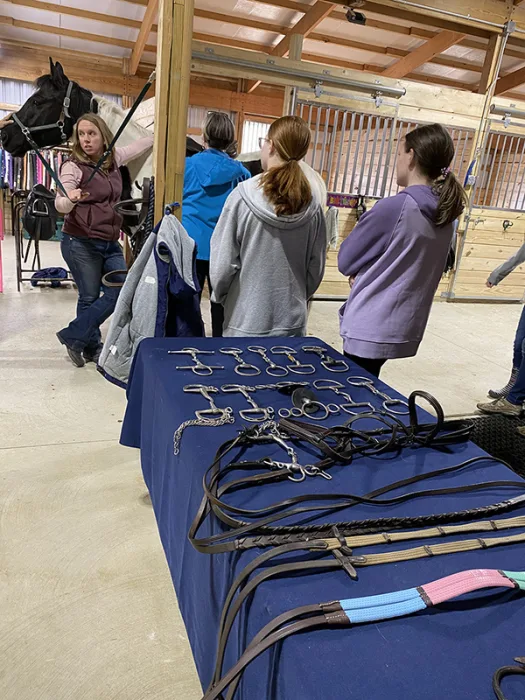
In a lesson program, from the first lesson, we have to foster our students’ interests in learning more than just how to ride.
Horsemanship, and unmounted lessons, should be a regular part of all riding programs. We need to encourage our students to want to learn about the whole horse, about their care, their conformation, the ways we tell if they are healthy and fit. We need to teach about tack, about different types of saddles and bridles and bits and when and how we use them. We need to teach students how to keep leather clean and conditioned, and they should do this regularly, even with lesson tack. We need to teach the difference between a cooler and a scrim and a stable blanket and a turnout sheet, and our students should know when each is appropriate to put on or take off their horse.
We need to teach our students to care about the nitty-gritty details and how those details impact the welfare of our horses and the quality of our rides.
In my own lesson program, I’ve come across parents who believed that every minute of a lesson should be spent on a horse, and they had to be convinced otherwise. I once turned down a parent who offered to “pay a little more” so that the horse was ready for her child upon arrival, so the child didn’t have to do “all that other stuff.” I told that parent that if her child wasn’t interested in “that other stuff,” then the child didn’t belong at my barn.
At our barn, there is no riding without horsemanship.
It’s difficult to fit every aspect of horsemanship into a regular lesson program, but I believe it’s vital to the future of the industry that we continue to intentionally raise strong horsemen and horsewomen, rather than just pretty riders.
When I explain the importance of horsemanship within a riding program, parents quickly buy into the idea that I want their child to become a well-rounded equestrian and not just a kid who can sit on a horse.
Horsemanship (and the lack thereof) has been showing up with more frequency in our equine social media platforms, and for good reason. As an industry, we’re seeing a decline in “barn rats” —the kids who want to spend all day at the barn watching and learning from more advanced riders. There are many factors contributing to this decline, but two seem to be most significant.
First, there’s a greater fear of liability these days, and farm owners and instructors are hesitant to put themselves at greater risk by letting children stay longer on their property without one-on-one attention.
Second, today’s kids are horrendously over-scheduled. For my students, riding is just one of myriad activities they participate in during a week, and there’s often a mad rush getting to or from the barn. Often, the only time we have with our students is that precious hour once a week, and we’re hard-pressed to fit it all into that time frame.
I took my first riding lesson at age 9, and the first thing I was taught at that very first lesson was “this is a halter, and this a lead rope, and there’s your pony, over there in that field.” I have been responsible—at every lesson for my entire life—for preparing my mount for each ride, and taking care of him afterwards.
ADVERTISEMENT
And with very, very few exceptions, this should be the case at any riding lesson program.
Our program, like so many others, requires our students to be involved in the grooming and tacking process (and when they have mastered these skills, they earn the privilege to arrive early and groom and tack their horses independently).
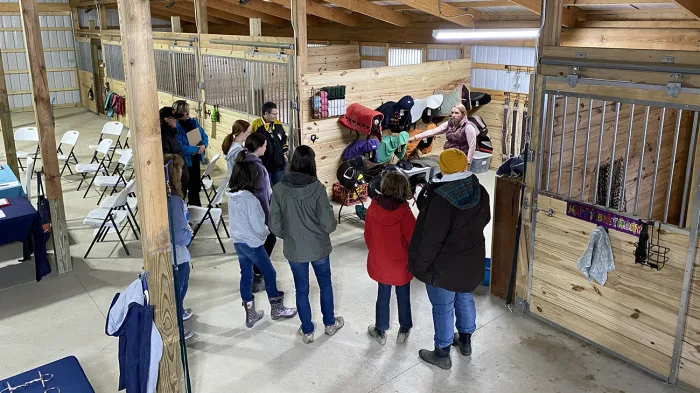
At their first lesson, our students learn—with their instructor’s help—how to put on a halter and attach a lead rope, and how to use a curry comb, brush and hoof pick. In the next weeks and months, they learn to safely lead their horses out of their stalls or their pastures, attaching their horse in the crossties without losing contact.
They learn the names and functions of the various grooming tools, and they learn to put their hands all over their horses, checking for cuts or inflammation or rashes that might need treated before the ride, or that could prevent a ride altogether. They learn the parts of their saddle and bridle, and they learn how to put them on correctly and how to safety-check their equipment. They learn how to properly warm up and cool down their horse, and they learn what to do after a lesson, before putting their horse away, based on the time of year and level of work. My regular students, even my littlest ones, can sponge off a sweaty horse on a hot day, or slide on a cooler over their horse’s damp coat when there’s a chill in the air.
And at the very, very least, these skills are what all riding students should know, and these are easily incorporated into the beginning and end of every lesson. I know most people reading this will agree.
But what about everything else?
It’s difficult to fit every aspect of horsemanship into a regular lesson program, but I believe it’s vital to the future of the industry that we continue to intentionally raise strong horsemen and horsewomen, rather than just pretty riders.
If you’re looking for ways to incorporate more horsemanship into your program, here are five suggestions:
1. Make unmounted lessons a regular part of your program.
While the option of unmounted lessons during bad weather makes a lot of sense, especially for instructors without access to an indoor, unmounted lessons can end up feeling like “less” than mounted lessons. When kids don’t know they’re not riding until they arrive at the barn, unmounted lessons are often met with disappointment.
If you want students to value and look forward to unmounted lessons, consider making them a regular part of your program.
For example, if you sell monthly packages for lessons, perhaps any month with a fifth week could use that fifth week for unmounted lessons. Or if you book lessons in a sessions format, you could schedule an unmounted horsemanship lesson intentionally within that program, perhaps as the first or last lesson of a session, or midway through. Having scheduled horsemanship/unmounted lessons gives your horses a break while you emphasize much-needed skills with your students.
2. Create a horsemanship curriculum that supports your barn’s goals.
Rather than teaching unmounted horsemanship lessons willy-nilly, create an organized and intentional horsemanship program that works for your stable. Think about your specific program, and what it is that students need to know:
Do you offer leasing or boarding? Base your horsemanship program around what someone would need to know to care for their own horse.
Does your program take students to shows? Think about what your students need to know to be a safe and involved member of your show team.
Does your program offer trail riding? Plan horsemanship lessons that teach safety and skills needed outside the arena.
Make a list of the horsemanship skills that you want your riders to learn, and then put them in a logical order so that the skills and knowledge builds off of earlier skills. You could share this list with students, allow them to track skills as they are learned, and even offer prizes to students as they master horsemanship skills and knowledge!
ADVERTISEMENT
3. Incorporate horsemanship into each lesson.
It’s easy to fit grooming and tacking into lessons, but think about how and when you can go above and beyond those basics. If your students get their horses from a pasture with other horses, take a few minutes at the gate to talk about horse body language or herd dynamics. Or talk about the breeds, colors and markings of the horses you can see.
Grooming is a great time to teach horse body parts or talk about common equine injuries and ailments.
Warm-up and cool-down time at the beginning and end of lessons is another great time to share general horsemanship knowledge and inspire riders to be interested in learning more about their equine partners.
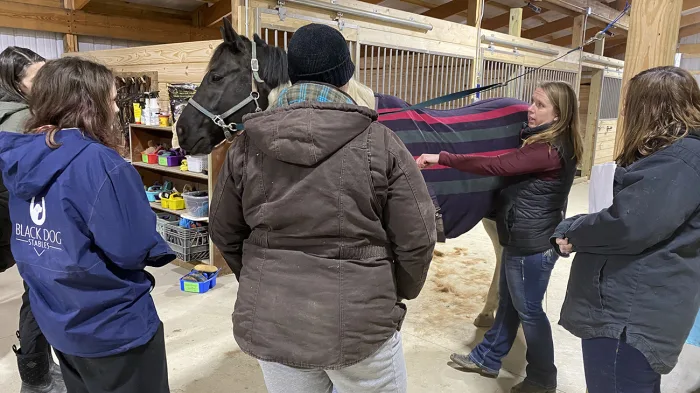
4. Engage students outside of regular lessons.
Our farm does not have boarders or lease out our own horses; we only offer riding lessons, summer camps and other educational programs. Because our students only come to the barn for structured lessons, and don’t regularly get to take part in aspects of horsemanship usually covered by the horse’s owners, we’ve tried to create extra opportunities for students to visit and experience these additional aspects of horse care.
When possible, we schedule veterinarian and farrier appointments after school hours or on weekends so our older lesson students can come observe and ask questions.
We have barn work days where students come and help paint jumps or clean tack. (There’s always pizza and lots of talk about the latest LeMieux color schemes—and we love seeing our students off their phones and engaging with each other.) We encourage our teenage students to volunteer at our camp programs; they leave at the end of the week with lots of new knowledge and service hours, too!
We offer a more focused, educational horsemanship program as well. Meagan Greygor of Nonpareil Equine Services, our farm’s upper-level instructor, holds a two-hour horsemanship clinic, open to the public. Each of these clinics dives deeper into some aspect of horsemanship that we may touch on in lessons but not get to explore in depth: saddles, bridles and bits; seasonal horse care; horse and rider fitness plans; blanketing; or horse show prep, for example. These intensive clinics, geared towards older teen and adult riders, are a combination of lecture and hands-on activities. They’re a great way for more serious and interested older students to really deepen their knowledge.
5. Don’t reinvent the wheel.
There are plenty of resources out there for unmounted lessons and clinics; you don’t need to build something from scratch.
Pony Club manuals and 4-H materials offer excellent resources for riders of all levels and ages. There are also many online resources geared towards horsemanship education. Two of the most popular, www.horsesenselearninglevels.com and www.horseridinglessonplans.com, have ready-to-use unmounted lesson materials including worksheets and structured lesson plans to help you intentionally add more horsemanship to your program. Pick and choose the resources that work for your stable, your students, and your goals.
I often think about my teenage volunteer who, despite three years of lessons, didn’t know how to tack up. By the time our summer together ended, she could saddle and bridle; she could fill hay bags and scrub water buckets and clean a stall; she knew what the horses ate and why. She knew the colors and markings and breeds of all of our horses and ponies; she knew the parts of the saddle and bridle; and she could name two dozen horse body parts. And most importantly, she could teach these things to our campers with confidence. I hope she is still riding. And I hope that her time with us instilled in her the knowledge that there’s so much more to horses than just the time spent in the saddle.
Sarah K. Susa is the owner of Black Dog Stables just north of Pittsburgh, where she resides with her husband and young son. She has a B.A. in English and Creative Writing from Allegheny College and an M.Ed. from The University of Pennsylvania. She teaches high school English full-time, teaches riding lessons and facilitates educational programs at Black Dog Stables, and has no idea what you mean by the concept of free time.







